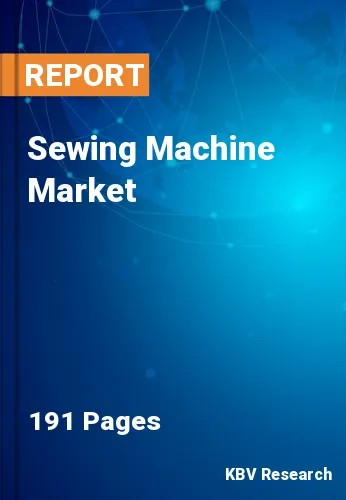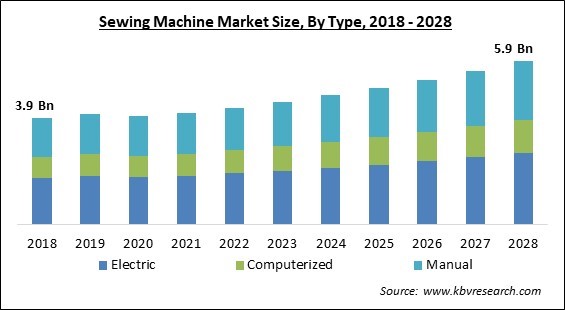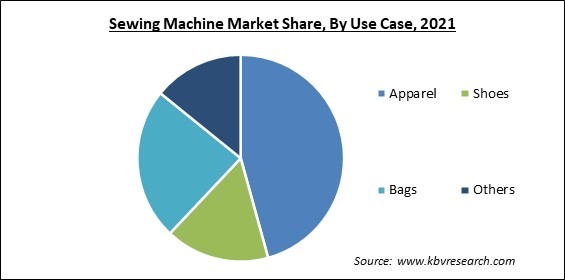
The Global Sewing Machine Market size is expected to reach $5.9 billion by 2028, rising at a market growth of 5.7% CAGR during the forecast period.
Fabric and other malleable materials are stitched together with threads using a sewing machine. The many parts of a sewing machine and their numerous functions assist the operator in making full use of the machine. Sewing machines of many varieties are used in the production of clothing and other items. The fabrics are readily operated in and out of a modern sewing machine with the convenience of thimbles, needles, and other hand sewing equipment, thereby automating the numerous stitching procedures and saving time. Sewing machines vary in size, cost, look, and task, with some being larger, faster, and more complicated. Needlestick injuries are common on modern sewing machines, hence safety equipment like needle guards are employed to avoid them.
With feeding devices, the sewing machine regulates the fabric and creates a flawless stitch to unite the textiles. It has several components and attachments, each with its own function and importance. Domestic sewing machines and industrial sewing machines are the two types of sewing machines. Housewives, connoisseurs, and artisans work in the domestic sub-segment to repair ruined clothing. These machines are used for creating imaginative embroideries on clothing and canvas, as well as stitching basic domestic clothing in a variety of situations. In the approaching years, this market is projected to be extremely popular. Car upholstery, bags, apparels, furniture products, clothing, and shoes are examples of industries that require sewing machines.
Sergers are another name for overlocked sewing machines. Sewing or overlocking the fabric is done with these machines. In basic terms, these machines are used by professionals or tailors to connect or stitch the edges of the fabric together (edging single cloth as well). They are used to give the garments a finished look. Edging napkins, elastic Hemming or elastic seaming in lingerie design, edging curtains, overlocking on pillow covers, and many more creative crafts are all done with this machine in the garment industry.

The COVID-19 pandemic caused lockdowns and restricted movement for individuals all across the world and resulted in millions of deaths across the world. As a result of the increased time spent at home, people began to take up new hobbies such as sewing, quilting, and knitting. Despite the supply chain delays, numerous industry participants saw greater sales during the pandemic, owing to increased demand for sewing machines from households. The COVID-19 dilemma has enhanced the necessity of digitization and automation for the sewing machine sector. Sewing machine manufacturers are being pushed to innovate on their present product as well as workflow. Sewing machine makers can now adapt faster to changes in consumer demand, save money, and improve their operational efficiency due to advances in digital technology and communication tools.
Functional fabrics that are made of natural and synthetic fibers such as Vinyon, Spandex, Saran, Nomex, Modal, and others are known as technical textiles. The technical textile business is growing due to the numerous applications of these fibers in agriculture, building, clothing, and other industries. Technical textile qualities such as high strength and superior insulation, high thermal resistance, and an elevated propensity are expected to result in increased textile market income. Furthermore, a growing number of construction projects necessitate the use of tarpaulins, scaffolding nets, roofing materials, and canopies, among other useful textile products. Sewing machines are utilized to manufacture these technical textiles, and thus, the growing demand for these technical textiles has a positive influence on the sewing machine market.
The garment industry has grown tremendously as a result of continually changing fashion trends. The young population prefers to change their wardrobe frequently. This is enabled by their rising disposable income. In developing countries such as China and India, where the majority of the population is relatively young, the rise in disposable income is driving the demand for the latest and most fashionable clothing. Another factor leading to the high demand for clothing is social media and social media influencers that promote the latest trends amongst the larger population. Social media is used effectively by clothing and fashion brands to keep consumers interested in keeping up with the latest trends.
The majority of sewing machines are extremely safe to operate and have built-in safety mechanisms to prevent injury. At the same time, reading the owner's handbook and following all of its safety precautions is an important aspect of learning to use a new machine. Sewing machines come with a greater risk of serious injury than working with a needle and thread. They are also a potential source of electrical issues including shocks and short circuits. Sewing requires some skill and patience, and it improves with practice. It can be difficult and aggravating. Sewing can be physically demanding.

Based on Type, the market is segmented Electric, Computerized, and Manual. The electric segment acquired the largest revenue share in the sewing machine market in 2021. Electric sewing machines have a number of advantages, including as high quality, improved stitching, and accuracy, which appeal to a broad variety of customers. These gadgets are mostly used by professionals/tailors and experts, as they enable higher precision in their work. The growing demand for electric sewing machines is due to the increased adoption of electric sewing machines for production in commercial and industrial applications.
Based on Application, the market is segmented into Industrial, Commercial, and Residential. The residential segment registered a significant revenue share in the sewing machine market in 2021. This is due to the rise of sewing as a hobby. Due to the country-wide lockdowns imposed in most countries, stitching became more popular as a hobby. Another reason why this hobby is gained traction is due to its earning potential. A lot of homemakers who start sewing merely as a hobby end up earning some extra income by catering to sewing needs of their neighbors.
Based on Use Case, the market is segmented into Apparel, Shoes, Bags, and Others. The apparel segment acquired the largest revenue share in the sewing machine market in 2021. The demand for men's and women's clothing is precisely proportionate to the population. Since the production of apparel requires sewing machines, this has caused the rise in demand for sewing machines for production of apparel. The apparel market is influenced by changing styles and fashion trends. Due to the continually and frequently changing fashion trends, both men and women change their wardrobes on a regular basis. Since the launch of the internet selling platform, demand for garments has continued to rise.
| Report Attribute | Details |
|---|---|
| Market size value in 2021 | USD 4 Billion |
| Market size forecast in 2028 | USD 5.9 Billion |
| Base Year | 2021 |
| Historical Period | 2018 to 2020 |
| Forecast Period | 2022 to 2028 |
| Revenue Growth Rate | CAGR of 5.7% from 2022 to 2028 |
| Number of Pages | 191 |
| Number of Tables | 360 |
| Report coverage | Market Trends, Revenue Estimation and Forecast, Segmentation Analysis, Regional and Country Breakdown, Companies Strategic Developments, Company Profiling |
| Segments covered | Type, Application, Use Case, Region |
| Country scope | US, Canada, Mexico, Germany, UK, France, Russia, Spain, Italy, China, Japan, India, South Korea, Singapore, Malaysia, Brazil, Argentina, UAE, Saudi Arabia, South Africa, Nigeria |
| Growth Drivers |
|
| Restraints |
|
Based on Regions, the market is segmented into North America, Europe, Asia Pacific, and Latin America, Middle East & Africa. Asia Pacific acquired the largest revenue share in the sewing machine market in 2021. China and Japan, for example, contribute significantly to market revenue. The growing textile sector in developing countries such as Bangladesh, Vietnam is also leading to high demand for sewing machines in the region. One of the most important driving forces for the region's growth is the increasing number of international corporations investing across the region. The availability of low-cost labor and materials throughout the region has helped the region's market income.
Free Valuable Insights: Global Sewing Machine Market size to reach USD 5.9 Billion by 2028
The market research report covers the analysis of key stake holders of the market. Key companies profiled in the report include Mitsubishi Electric Corporation, Juki Corporation, Brother Industries, Ltd., Bernina International AG, Janome Corporation, Merrow Sewing Machine Co., Necchi Italia s.r.l., SVP-Singer Holdings, Inc., Tacony Corporation, and Usha International Ltd.
By Type
By Application
By Use Case
By Geography
The sewing machine market size is projected to reach USD 5.9 billion by 2028.
Rising demand for technical textiles are driving the market in coming years, however, safety concerns and learning curve for beginners growth of the market.
Mitsubishi Electric Corporation, Juki Corporation, Brother Industries, Ltd., Bernina International AG, Janome Corporation, Merrow Sewing Machine Co., Necchi Italia s.r.l., SVP-Singer Holdings, Inc., Tacony Corporation, and Usha International Ltd.
The Industrial segment acquired maximum revenue share in the Global Sewing Machine Market by Application in 2021, thereby, achieving a market value of $4.0 billion by 2028.
The Shoes market has shown growth rate of 6.6% during (2022 - 2028).
The Asia Pacific market dominated the Global Sewing Machine Market by Region in 2021, and would continue to be a dominant market till 2028.
Our team of dedicated experts can provide you with attractive expansion opportunities for your business.
